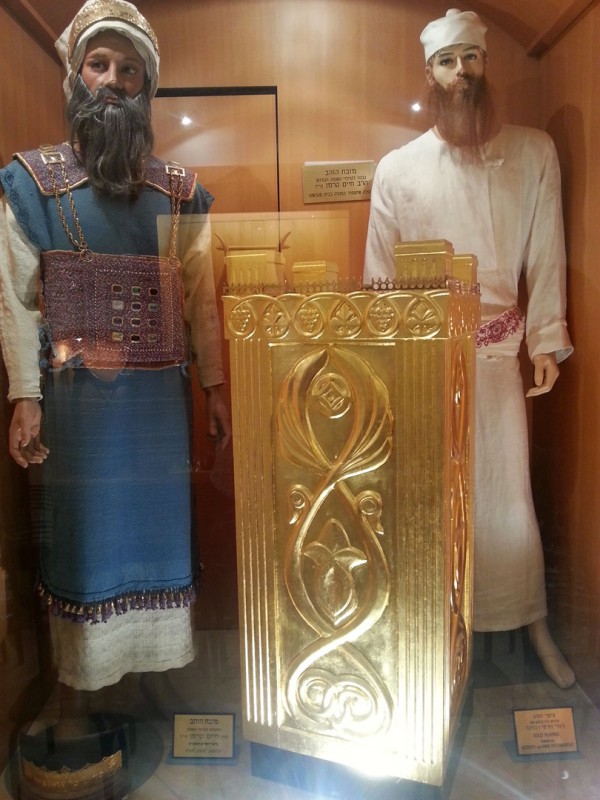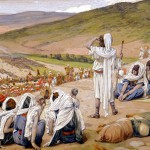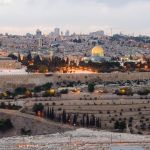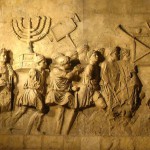“I have consecrated this Temple, which you have built, by putting My Name there forever. My eyes and My heart will always be there.” (1 Kings 9:3)
In the 25th year of the Babylonian exile, Ezekiel (Yechezkal) prophesied that the Holy Temple would be rebuilt. (Ezekiel 40:1)
And while chapters 40–48 of Ezekiel describe that Temple in great detail, when the Israelites emerged from exile and rebuilt the Second Temple, it did not follow the specifications set forth by Ezekiel.
Jewish commentators argue that Ezekiel’s Temple was not built because it was intended to be an everlasting edifice connected with everlasting redemption, something the Israelites were not ready to receive.
When the Jewish People emerged from exile at the decree of Babylon’s King Cyrus, their repentance was only partial, and many remained under foreign rule. Therefore, the Temple they built was not according to Ezekiel’s vision, but according to God’s instructions that were given through Haggai and Zechariah (Ezra 6:14–15).
While the Second Temple was impressive, it was not as grand as the Temple Ezekiel saw. Even Herod’s extensive renovations could not match it; nevertheless, the historian Josephus described the Mount as awe-inspiring.
Still, the gem in the crown was the Temple itself. The building’s white marble and gold glistened in the sun to such an extent that it was blinding in the daylight.
Like the First Temple, which was destroyed because of the sins of sexual immorality, murder, and idolatry, the Second Temple was also destroyed because of sin; however, it was not destroyed for the same kind of sin.
According to Jewish tradition, it was destroyed for the sin of sinat chinam (baseless hatred), a sin that often manifests as internal strife and conflict.
This is not the type of hatred that arises when someone misuses us. It is irrational animosity because something or someone is different.
It is the type of hatred that arises when we become the center of our own universe. Other people are relegated to the sidelines.
When we are guilty of baseless hatred, even God, though we may believe in Him, comes second.
Currently, during the three-week period between the Seventeenth of Tammuz and the Ninth of Av, observant Jews are reflecting on and mourning the great tragedy this sin caused.
With the Holy Temple destroyed and the exile Rome initiated, the Jewish People wandered for 2,000 years through alien nations, lands and cultures. But in these end times, God has brought His people home in fulfillment of many Bible prophecies, and now the Jewish People look to the rebuilding of the Temple with confidence.
In the meantime, some Jewish people feel that the remedy for baseless hatred (sinat chinam) is the deliberate practice of baseless love (ahavat chinam)—a love that begins in the head by noting positive traits without whitewashing less desirable ones. (Rav Kook)
When Will the Temple Be Built?
“This is the law of the temple: All the surrounding area on top of the mountain will be most holy. Such is the law of the temple.” (Ezekiel 43:12)
“A generation in which the Temple is not built is considered to be one in which it was destroyed,” states the 4th–5th century Jerusalem Talmud, underlining an age-old Jewish prayer and yearning for the rebuilding of God’s House in Jerusalem.
However, a divide had emerged in Jewish thought after AD 70, when the Second Temple was destroyed. To this day, one school of thought believes the Temple must be rebuilt before the Messiah comes in the final redemption, while the other believes the Messiah Himself must restore the Temple.
Today on the Temple Mount, which is believed by Orthodox Jews to be imbued with the full holiness of God since the days of Solomon when “the glory of the Lord filled the house (2 Chronicles 7:1),” Jewish prayer is under strict censure through the involvement of the Jordanian waqf.
Nevertheless, Jews throughout the world continue to pray toward the Temple grounds, with synagogues erected in a compass-aware manner that faces toward Jerusalem and Har HaMoria (הר המוריה, Mount Moriah)—called locally Har HaBayit (הר הבית, Mount of the Home).

The Old Synagogue, which is an Orthodox Jewish synagogue in Krakow, Poland is the oldest synagogue building still standing in Poland. It was built in 1407 (or 1492) and rebuilt in 1570 under the supervision of Mateo Gucci, a Polish-Italian architect and sculptor.
Jews remember the long-destroyed Temple through daily prayer for its restoration and by studying God’s explicit instructions for how to build it, as given to King David, who beseeched his son Solomon “to build His holy Temple. Now do it—and do it with determination.” (1 Chronicles 28:10)
By 586 BC, Solomon’s Temple and Jerusalem had fallen. Fourteen years after the city fell, the prophet Ezekiel saw the Messianic Temple to come while exiled with Israel under King Nebuchadnezzar in Babylon:
“The glory of the Lord entered the temple through the gate facing east. … He said: ‘Son of man, this is the place of my throne and the place for the soles of My feet. This is where I will live among the Israelites forever. The people of Israel will never again defile My holy name—neither they nor their kings …'” (Ezekiel 43:4, 7)
In Ezekiel’s vision of the Era of Redemption, God directed him to reveal the details of the Messianic Temple:
“Describe the Temple to the people of Israel, that they may be ashamed of their sins. Let them consider its perfection, and if they are ashamed of all they have done, make known to them the design of the Temple—its arrangement, its exits and entrances—its whole design and all its regulations and laws. Write these down before them so that they may be faithful to its design and follow all its regulations.” (Ezekiel 43:10–11)

This plan of Ezekiel’s Temple was drawn by the 19th-century French architect and Bible scholar Charles Chipiez.
In the Midrash, the prophet Ezekiel speaks with God at the time of his Ezekiel 43 vision and asks, “Why are You telling me to go and tell Israel the form of the House … They are now in exile in the land of our enemies. Is there anything they can do? Let them be until they return from exile. Then, I will go and inform them.”
In response, God tells Ezekiel that despite the exile, His House should not be ignored: “The study of the Torah’s (design of the Temple) can be equated to its construction. Go, tell them to study the form of the Beit HaMikdash (בית מקדש, The Holy Temple). As a reward for their study and their occupation with it, I will consider it as if they actually built the Beit HaMikdash.” (Midrash Tanchuma, Tzac, Sec. 4)

Tourists in Jerusalem marvel at the scale of this model of the Temple Mount during the Second Temple period.
Controversy Over Building the Third Temple
“The honor of this last house will be greater than that of the first, says the Lord of Hosts; and in this place I will grant peace, says the Lord of Hosts.” (Haggai 2:9)
In our day, now that the Jewish People are back in the Land and Jerusalem is under rightful Jewish control, the Temple can actually be built.
In fact, the Temple Institute has created all of the necessary ritual objects for the Temple Service, down to the priestly garments and the copper vessels.
Two things remain. The first is the most obvious: a spot to build it. Of course, this is the most noticeable remaining issue since the Temple Mount, though held by Israel, is under the administrative control of the Jordanian waqf.
Moreover, the traditional location on the Mount where the First and Second Temple stood is occupied by the Muslim Dome of the Rock. The presence of the Dome of the Rock and the even more revered Al-Aqsa Mosque on the Mount causes many Muslims to forcefully resist even the idea of rebuilding the Jewish Temple there.
According to Temple Institute Director Chaim Richman, who has led the creation and compilation of many furnishings and vestments for the Temple, actual “rubble-raising” would likely be seen as rabble-rousing in the international political realm. (Temple Institute)

At the heart of the Dome of the Rock on the Temple Mount is the Foundation Stone. This stone is traditionally considered the holiest site in Judaism since the Holy of Holies was thought to be located on it. It is, therefore, believed to be the spiritual junction between Heaven and Earth.
When the Second Temple was built, the political will of a superpower was behind the effort.
That will arose from a move of God’s Spirit.
It was only when the Lord “moved the heart of Cyrus king of Persia” to decree the Jerusalem temple’s rebuilding that “everyone whose heart God had moved—prepared to go up and build the house of the Lord in Jerusalem.” (Ezra 1:1, 5)
Today, political will is strongly opposed to the building of a Temple on the Mount, and only God can once again change that fact.
The second issue that remains is the Parah Adumah (Red Heifer), whose ashes are mixed with the “water of remission” to purify the Levites and the Kohanim so they may enter the Temple.
Without it the Divine Service of the Holy Temple cannot be resumed even if a Temple were built.
But that looks hopeful, since a rare, spotless red heifer was born recently on an undisclosed farm in the United States. Other potential candidates have been discovered over the years, only to sprout small black hairs or other disqualifying features.
If this heifer is proclaimed to be the official tenth red heifer, it is hoped that it will usher in the Messianic Age and that God will create the conditions to build the Messianic Temple and resume sacrificial services.

This young red cow, which was born in an undisclosed location in the United States, is the current candidate for the Parah Adumah (Red Heifer). The photo was taken while the animal was shedding its coat, which accounts for its somewhat patchy appearance.
Not One Stone
“Not one stone here will be left on another; every one will be thrown down.” (Mark 13:2)
As Yeshua HaMashiach (Jesus the Messiah) prophesied, not one stone remains of the monumental effort to build the Second Temple.
In fulfillment of Yeshua’s prophecy, the final pieces of God’s Temple were taken down between AD 687 and 691 with the construction of the Dome of the Rock.
The Western Wall—where Jews continue to pray in joy and sorrow—is the final standing remnant of King Herod’s expansions to the Temple Mount. Before their destruction, Herod’s walls enclosed the Temple Mount platform, more than tripling its size to 1,555,000 square feet.
In comparison, the Temple Mount, upon which the Holy Temple stood during King Solomon’s days, was only 410,105 square feet. It had five entrances and a central courtyard where the Temple was located.

An aerial shot of the Temple Mount platform. The gray dome of the Al-Aqsa Mosque can be seen in the foreground. Just behind it is the Muslim Dome of the Rock.
To equip the priests for their Temple tasks, Har haBayit held a House of Study, a lounge, weapons room, a tool room and a trumpet room.
Notably, the Temple’s eastern Shushan Gate, marked with a stone carving of the Persian city, recalls the hand of Ancient Persia in restoring the Temple.
Apparently, the Persian king worried about the possibility of a Jewish rebellion.
The picture of Shushan on the gate, the Persian capital city mentioned in the Book of Esther, was meant to be a reminder to the Jewish People, who were still the king’s subjects, that he was in charge.

The Dome of the Rock is situated over the Foundation Stone, where the Holy of Holies is thought to have been located.
Serving God at the Holy Temple
“They [priests] must be holy to their God and must not profane the name of their God. Because they present the food offerings to the Lord, the food of their God, they are to be holy.” (Leviticus 21:6)
The Holy Temple was the great centerpiece of the Jewish faith.
“The Temple was a symbol of G‑d: majestic, grand and awe-inspiring, because G‑d is majestic, grand and awe-inspiring. It was a shrine to G‑d and all the things that ‘G‑d’ means: responsibility, morality, ethics, love, compassion, humility,” Mendy Hecht writes on the Chabad website. “It was a place where one found spirituality: the Kohanim (כהנים, priests) silently serving in awe of G‑d beyond words, the Levites singing boisterous songs of love for G‑d, the pilgrims fine-tuning their relationship with G‑d, the sights, the sounds.”
God called the Kohanim from among the tribe of Levi in a command to Moses: “Anoint Aaron and his sons and consecrate them so they may serve me as priests.” (Exodus 30:30)
Their role was to serve God through sacred service, bringing sacrifices before God and remaining in a guarded state of purity.
Leviticus 21 outlines the rules for Aaron’s sons, the priests of Israel. These rules emphasize their role as spiritual leaders and the need for their utmost purity.
Included in those rules was a ban against touching the dead body of those outside their immediate family, against shaving their heads or edges of their beards, and against marrying a prostitute or a divorced woman.
The Kohanim were responsible for the sanctification of the most holy things, and only the high priest could enter the Most Holy Place in the midst of the Temple on Yom Kippur (יום כיפור, the Day of Atonement) once a year.

These priestly garments, which were recreated by the Temple Institute are on display at the Treasures of the Temple exhibition in Jerusalem.
In addition to ministering to God, the priests were responsible to bless the people daily in the Name of God:
“The Lord said to Moses, ‘Tell Aaron and his sons, “This is how you are to bless the Israelites. Say to them: ‘The Lord bless you and keep you; the Lord make His face shine on you and be gracious to you; the Lord turn His face toward you and give you peace.'”‘ So they will put My name on the Israelites, and I will bless them.” (Numbers 6:22–27)
While only the sons of Aaron could perform priestly duties of sacrifice, sanctification and blessings, the larger Levitical tribe was made responsible for transporting and taking care of the Mishkan (משכן, the Tabernacle) in the wilderness after the Exodus from Egypt.
When David appointed Solomon as king over Israel and assigned to him the construction of the Temple, he also issued relevant instructions to the Levites, 30 years and older:
“Of these, twenty-four thousand are to be in charge of the work of the temple of the Lord and six thousand are to be officials and judges. Four thousand are to be gatekeepers and four thousand are to praise the Lord with the musical instruments I have provided for that purpose.” (1 Chronicles 23:4–5)
David explained the change in duties, saying, “Since the Lord, the God of Israel, has granted rest to His people and has come to dwell in Jerusalem forever, the Levites no longer need to carry the tabernacle or any of the articles used in its service.” (1 Chronicles 23:25–26)
Every morning and evening, and at every burnt offering, the Levites were responsible to praise and thank the Lord.
They were also in charge of preparing the flour for the grain offerings, baking bread and matzah (yeast-free flatbread), and purifying all the sacred things. In addition, their duties involved taking care of the courtyards and the side rooms. Each family by their divisions took care of some aspect of the Temple.
Today, the Kohanim (priests) still play an important role in Jewish life. They bless their congregations with the Priestly Blessing at synagogues throughout the world and here at the Western Wall. In addition, descendants of the Kohanim and the Levites are honored with reading the first one or two sections of the Torah portion each Shabbat.
A Kohen also has an indispensable role in the pidyon haben (the redemption of the firstborn), (Exodus 13:13–16; Numbers 3:45–47). When a baby turns a month old, a Kohen is given five silver coins (equal to 96 grams).
King Messiah and Rebuilding the Temple
“Then have them make a sanctuary for Me, and I will dwell among them.” (Exodus 25:8)
Since AD 70, after the destruction of the Temple by the Romans, Jews have fervently prayed for the rebuilding of the Temple: “May it be Your will, Lord our God, and God of our fathers, that the Holy Temple be speedily rebuilt in our days.”
Many Jewish opinions and discussions exist about the nature and timing of the Third Temple. Some Jewish sages, such as Mosheh ben Maimon (Maimonides or “the Rambam”), assert that Jews must be involved in building it.
In the Mishneh Torah (a code of Jewish religious law), Maimonides states, “In future time, the King Mashiach (Messiah) will arise and renew the Davidic dynasty, restoring it to its initial sovereignty. He will rebuild the [Beit Ha] Mikdash and gather in the dispersed remnant of Israel.” (Sichos In English: Hilchos Melachim 11:1, 4)
Still others within Judaism state that the Temple will be rebuilt and then Messiah will return; for instance, the Temple Institute declares the following:
“The sages of Israel enigmatically stated that when the Messiah arrives, he will stand atop the roof of the Holy Temple and cry out: ‘Humble ones! The time of your redemption has arrived!’ Thus: the Temple will be built before the Messiah arrives.”
The prophets shed light on this structure, with both Jewish and Christian perspectives bringing in complex considerations:
“‘… suddenly the Lord you are seeking will come to His temple; the messenger of the covenant, whom you desire, will come,’ says the Lord Almighty. But who can endure the day of His coming? Who can stand when He appears? For He will be like a refiner’s fire or a launderer’s soap. He will sit as a refiner and purifier of silver; He will purify the Levites and refine them like gold and silver. Then the Lord will have men who will bring offerings in righteousness, and the offerings of Judah and Jerusalem will be acceptable to the Lord, as in days gone by, as in former years.” (Malachi 3:1–4)
Rambam states that the Messiah will reveal his identity when He builds the Temple, but others believe the Temple has already been “constructed by God and exists in the heavenly realms, waiting for the time when it will be able to descend to the earth.” (Sichos)
The Book of Revelation seems to resolve this, confirming that the New Jerusalem will descend from the heavenly realms and connecting this event with the world to come—a “new heaven and a new earth,” complete with God’s dwelling place among the people:
“I saw the Holy City, the new Jerusalem, coming down out of heaven from God, prepared as a bride beautifully dressed for her husband. And I heard a loud voice from the throne saying, ‘Look! God’s dwelling place is now among the people, and He will dwell with them. They will be His people, and God Himself will be with them and be their God.” (Revelation 21:2–3)
While this will happen in the world to come—after Yeshua’s thousand-year reign as King Messiah on the earth, after the final rebellion against God has been defeated, and after the Great White Throne Judgment has taken place, and mankind has been judged—Ezekiel’s Temple will be built in Jerusalem in these last days, most likely just before Messiah returns.
Many believe that it will be occupied first by the anti-Messiah (anti-Christ) during the Great Tribulation (2 Thessalonians 2:4), and then by the true Messiah, the Prince of Peace, Yeshua HaMashiach, during His millennial reign (Ezekiel 44:3).
We do know for certain that Ezekiel saw the Temple filled by the glory of God:
“I saw the glory of the God of Israel coming from the east. His voice was like the roar of rushing waters, and the land was radiant with His glory. … The glory of the Lord entered the temple through the gate facing east … and the glory of the Lord filled the temple.” (Ezekiel 43:2–5)
This day of God’s glorious filling in His Temple is just around the corner.







































